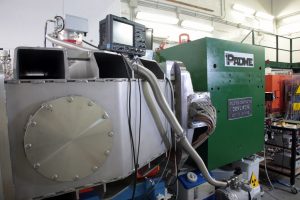 The pandemic that afflicts the planet is having important effects also on the scientific research and in particular on those fields where the experiment scale requires an international collaboration.
The pandemic that afflicts the planet is having important effects also on the scientific research and in particular on those fields where the experiment scale requires an international collaboration.
CERN, Fermilab and other major Physics laboratories in the world were closed, for a longer or shorter period, or considerably limited their activities. LNF, during the Italy’s lockdown, reduced to the minimum on site personnel, switching off the accelerators and keeping running only the essential activities but, after Easter, the new phase-2 regulations allowed the PADME experiment, whose data taking was scheduled between March-April, to starting again its “hunt” for dark matter.
It has long been known that a great abundance of “non-luminous” matter exists in the Universe, but it is far from clear what its nature is. In a nutshell, this is the engine that animates several fundamental physics experiments worldwide and PADME is one of these.
The PADME experiment optimized the detector last year and, according to the schedule, was expecting this year to start the data taking for the core of his scientific program.
The PADME experimental technique foresees to search for a new particle called “ dark photon” in the annihilation products of collisions that happen when positrons (antiparticle of electrons) from the linear accelerator collide with the electrons in a thin film of diamond. Some theories that in rare cases a dark photon is produced together with an ordinary photon. This particle remains invisible even after decaying and shows itself in the experimental apparatus through a missing mass signal.
The PADME experimental apparatus is able to measure the energy and the direction of the ordinary photon with extreme precision, therefore determining precisely the missing mass. If a dark photon is produced, the missing mass would have the exact value of the mass of the new particle. The main detectors of PADME are thus devices able to measure, with excellent resolution, the energy of photons (and electrons).
On July, 7 the experiment restarted the data taking on the beam line 1 of the BTF (Beam Test Facility) and, except for a break in August, will continue until October. The final goal of the experiment is to reach a 1/1000 sensitivity in the determination of the coupling constant between the dark and ordinary photon, recording 10000 billions (1013) positron on target collisions.
 INFN-LNF Laboratori Nazionali di Frascati
INFN-LNF Laboratori Nazionali di Frascati